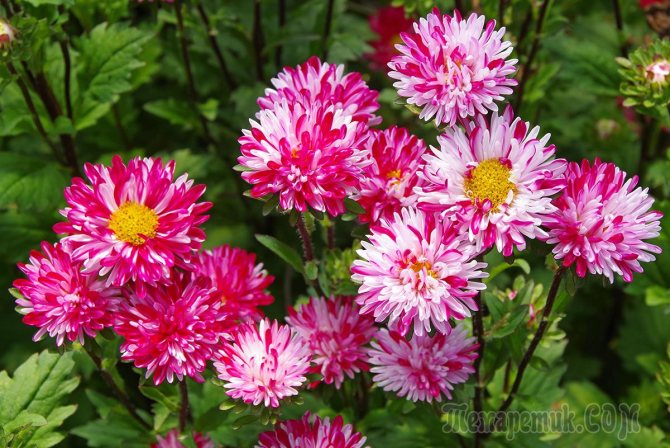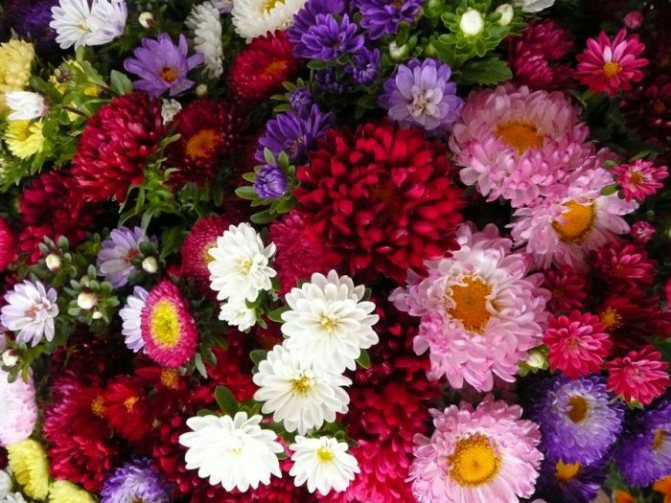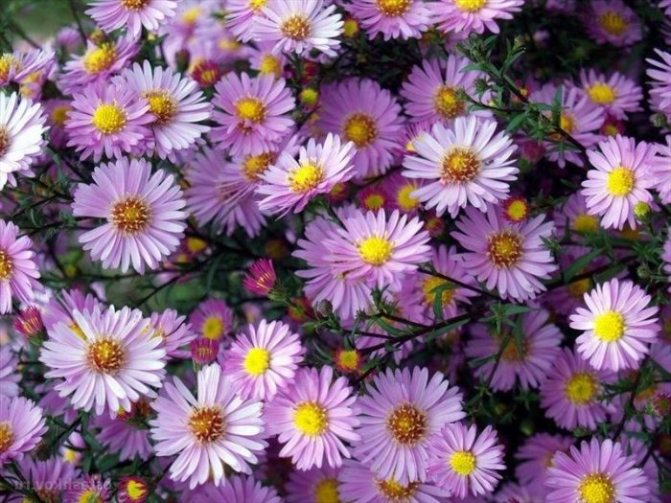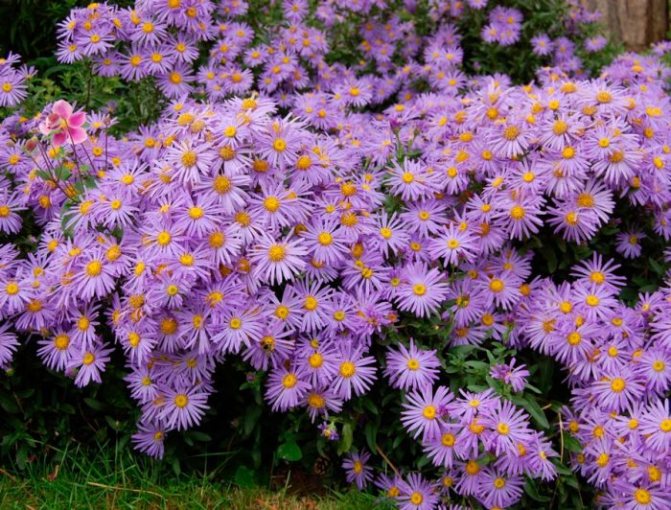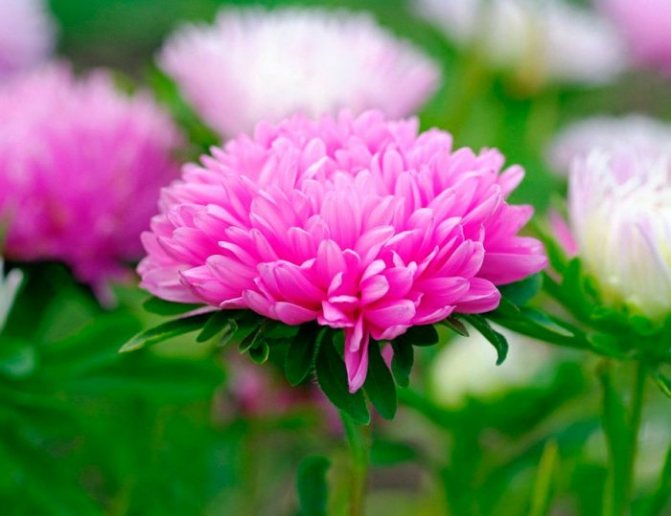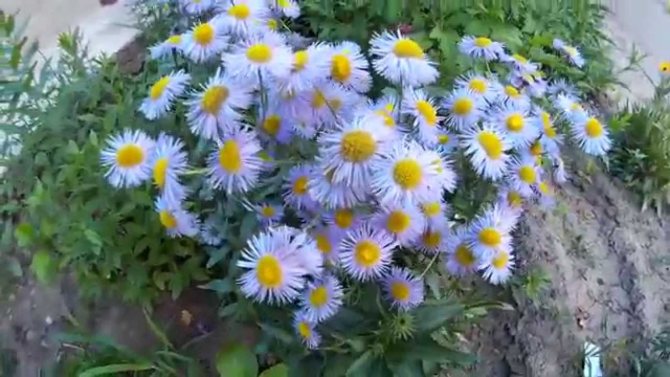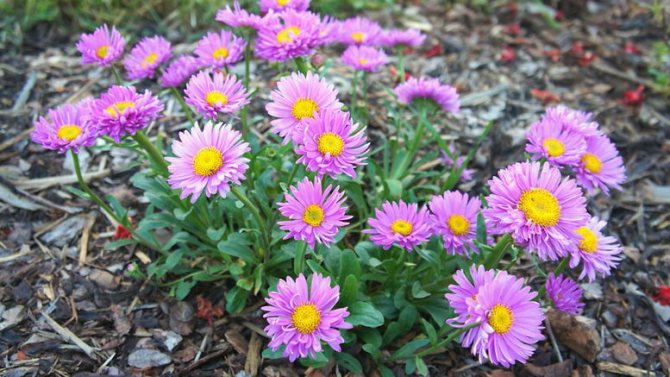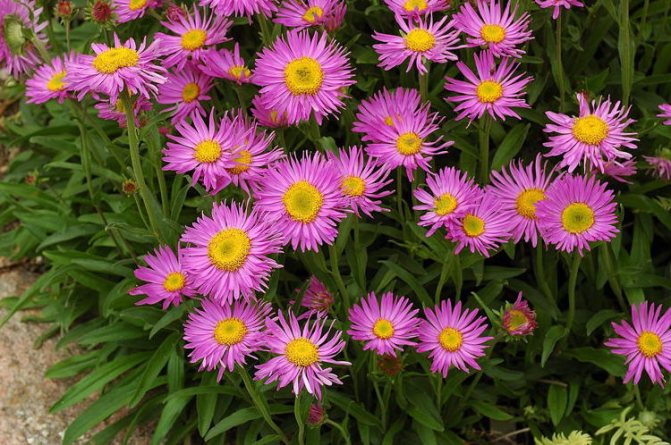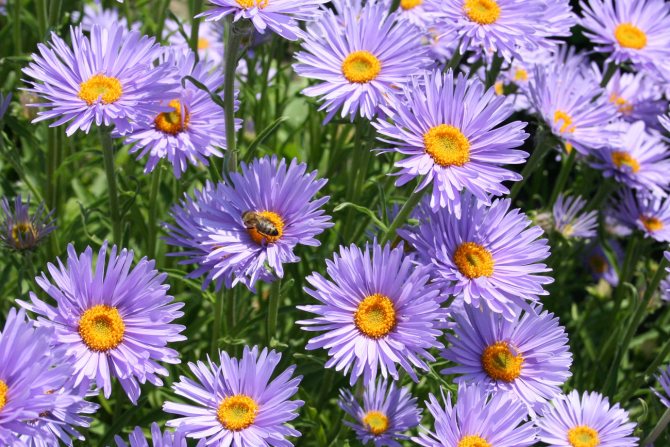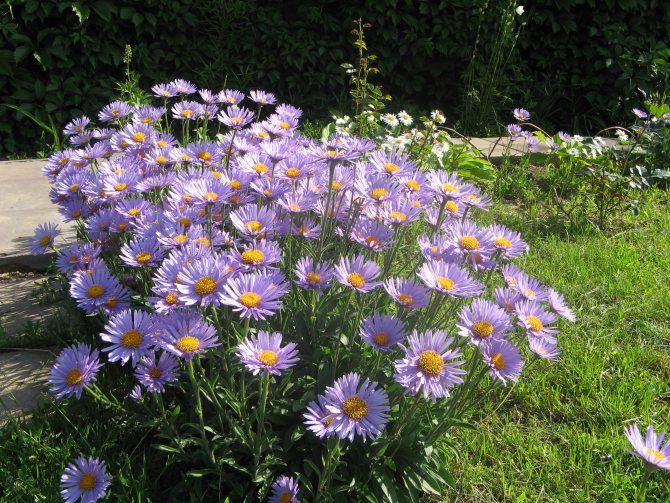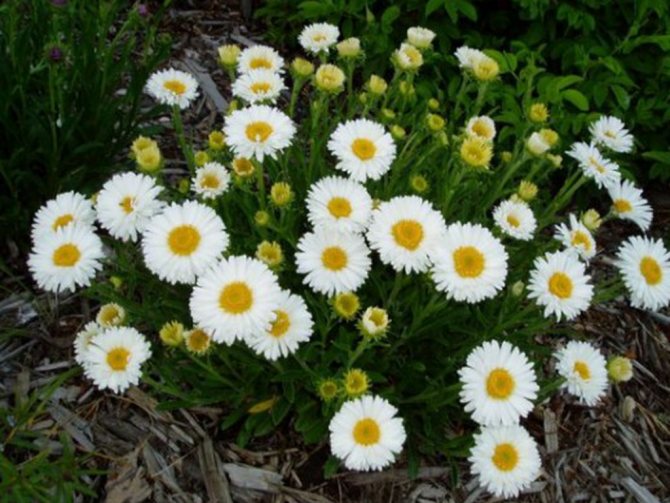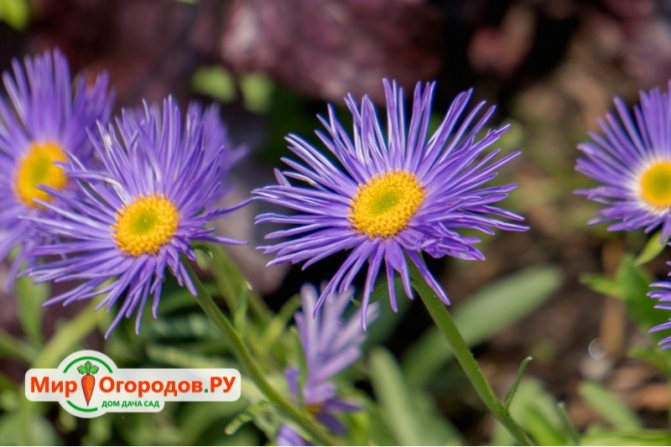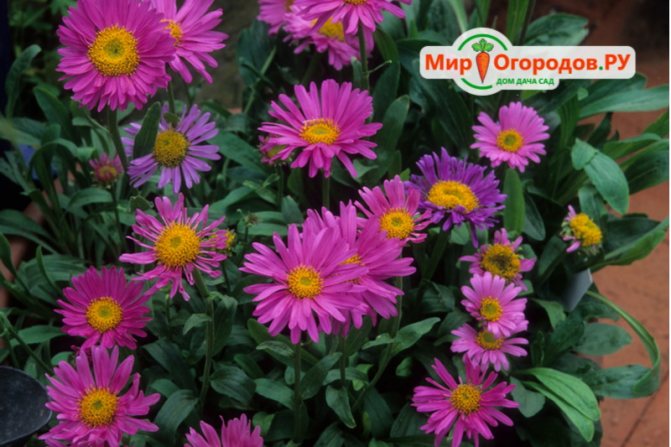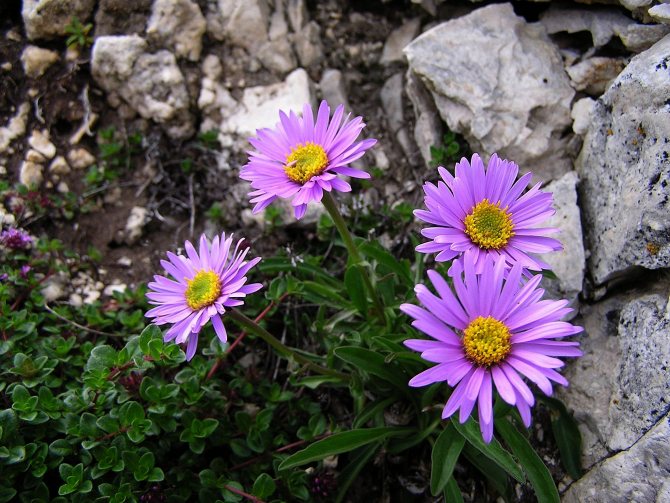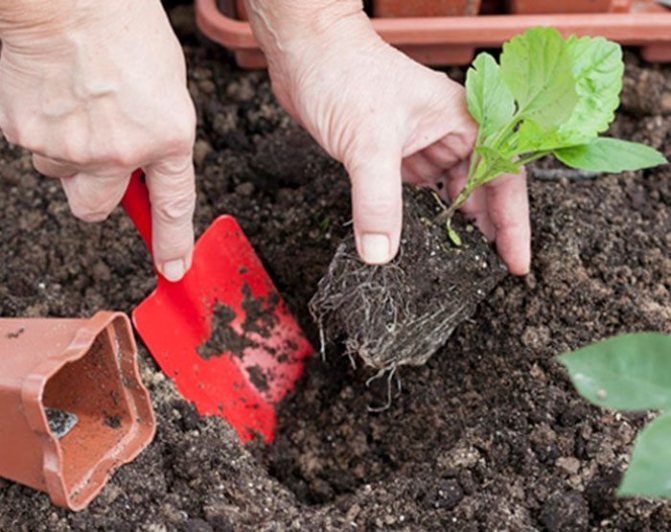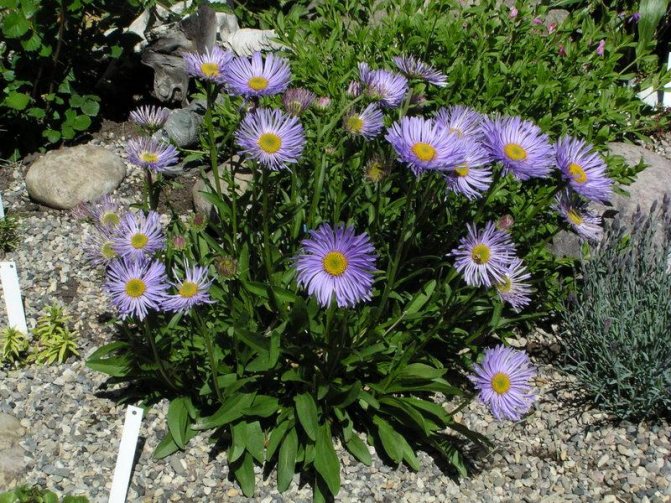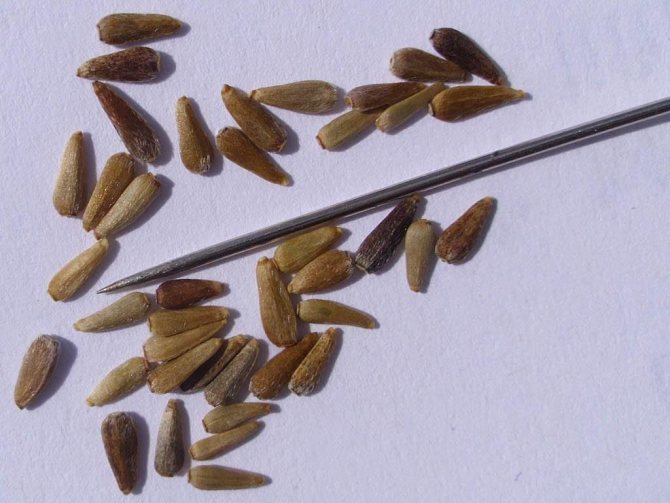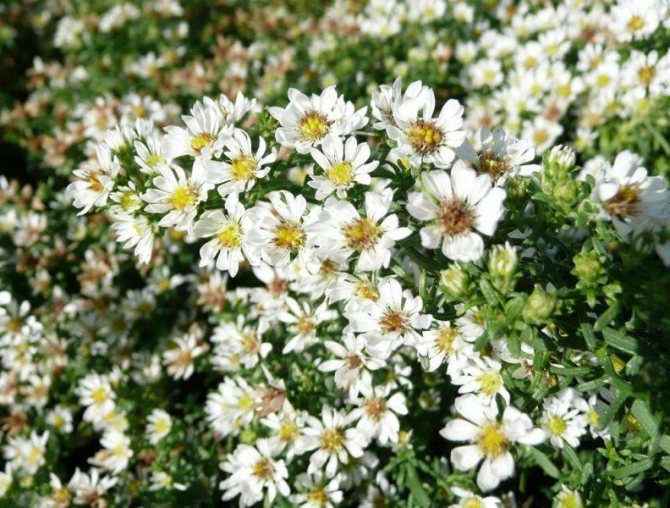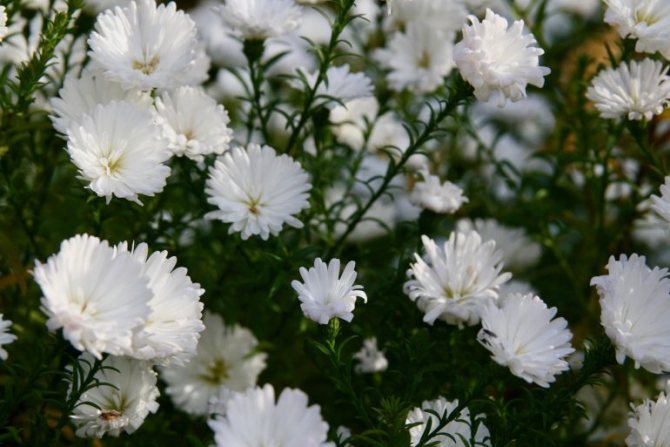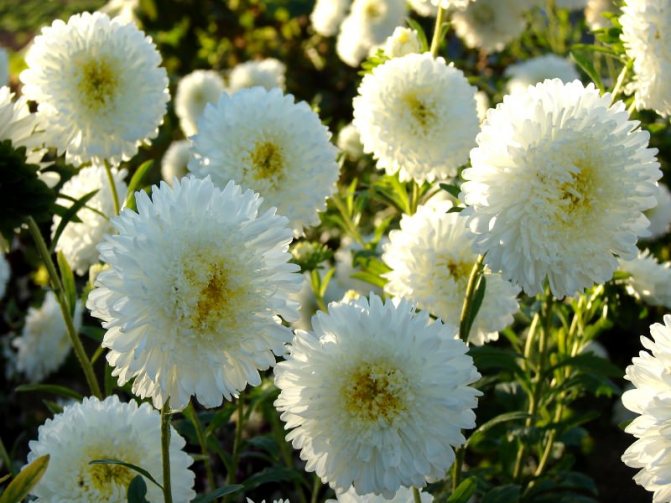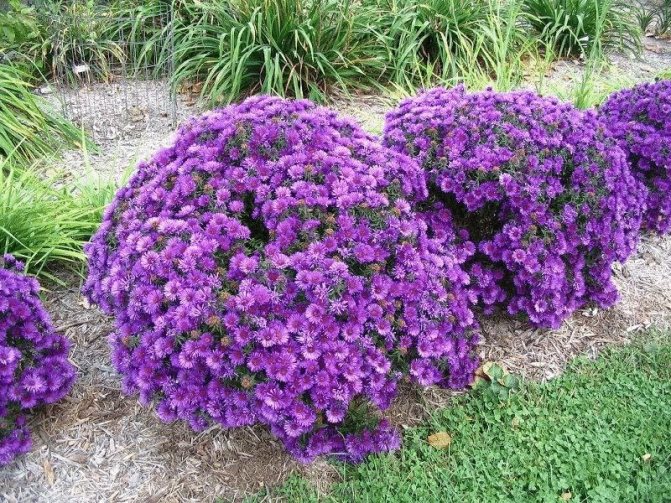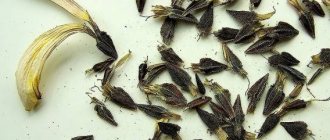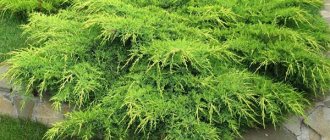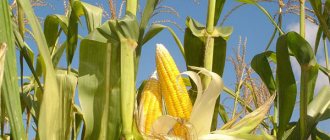Asters are probably the most popular flowers in flower beds, flower beds, garden beds, balconies and terraces in late autumn. The Asteraceae family includes 600 species - multi-colored annuals and perennials, which are traditionally associated with autumn. They can bloom from spring to the first frost, and the scale of flowers, types of inflorescences allows you to create beautiful flower beds.
In this article you will find information about annual and perennial asters - planting, growing and care in the open field, reproduction of plants, pests and diseases, and other information of interest to lovers of this beautiful flower.
Description of the plant
Heather aster is a beautiful perennial plant. It has straight, branched stems that are lowered to the ground. The height of the aster reaches no more than 1 meter. Leaves are linear, located along the stem and colored green. Small inflorescences in the form of baskets are the decoration of this plant. Their diameter does not exceed 1-1.5 cm.
Perennial heather aster can have one of the shades:
- white;
- pink;
- blue.
The middle of the inflorescence is red-brown or yellow-brown.
The leaves, located in three rows near the basket, are lanceolate and have a pointed shape. Active flowering of asters begins in the autumn and lasts from September to November. The plant bears fruit in the form of small flat seeds.
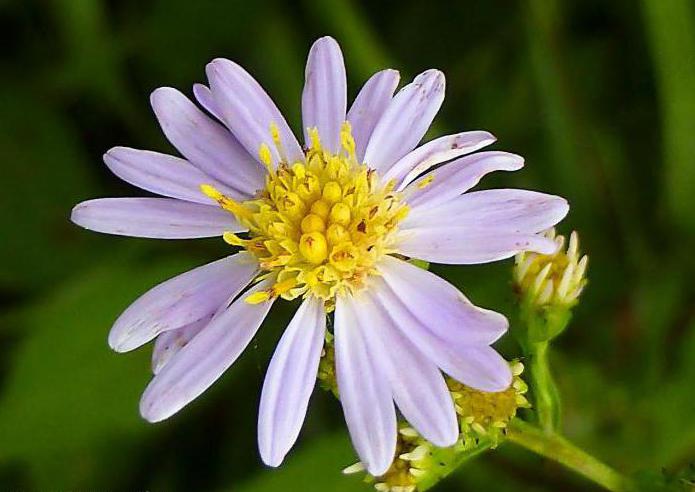
When and how it blooms
On average, each variety blooms for 30-45 days.
The inflorescence is a basket, in which the central tubular flowers have short yellow corollas, and the outer tier is formed of long flowers of pink, white, blue, purple. Some hybrids may have a completely single shade of a basket.
In shape, the inflorescence is usually similar to a chamomile, in which long petals can have a simple shape, pointed, with a wavy edge.
Most of the varieties available for free sale bloom in May-June, but in nurseries you can find others, blooming towards the end of summer.
When the bushes are in bloom, their water consumption increases significantly. If the rest of the time, with a sufficient amount of rains, the planting can not be watered at all, then during flowering, watering is necessary every week. Dry flowers, if seeds are not needed, are removed to make the bushes look more beautiful.
Characteristics of the species
Aster creeping heather is used to create landscape designs, since it is easy to form dense bushes of pyramidal and oval-pyramidal shapes from it. A huge number of flower baskets are woven into a single carpet. This type of aster is characterized by special properties that are ideal for decorative design of garden and park landscapes. Let's note the main qualities of an aster:
- Heather aster (perennial ground cover) has abundant and long flowering, which makes it possible to use it for decorating garden plots.
- The plant is frost-resistant, capable of withstanding temperature drops and temperature drops, up to -35 degrees.
On the territory of Russia, this species is not in great demand, but in the USA and Europe, almost no design of a garden plot is complete without a heather aster.


Gallery: alpine aster (25 photos)
Features of growing a plant
Aster heather does not belong to capricious crops, it is unpretentious in care and can grow in almost any conditions. However, there are requirements that it is desirable to fulfill in order for the plant to fully develop and please the eye:
- Asters like to grow in open sunny areas or where there is a slight partial shade.
- In order for aster heather to bloom profusely and develop well, it is necessary to create conditions that are as similar as possible to natural ones.
- You can not plant a flower in highly shaded areas. In this case, the plant will be painful, and parasites will begin to attack it.
- Almost any type of soil is suitable for growing a wild plant, except for marshy, saline and heavy soil.
- If cultivated aster heather is grown, planting and caring for it should be more careful. For this variety, you need to choose the right soil. Ideally, it should be loamy, fertilized, moderately moist, it is equally important to ensure good drainage.
- If the soil on the site does not contain trace elements necessary for normal growth, organic fertilizers must be applied before planting. This can be humus or compost.
- When planting in spring, it is advisable to add nitrogen fertilizers (20 g) to the soil, this will accelerate the growth of the plant.
- The most common way to reproduce flowers is by dividing. Planting the plant is best in the spring. Delenki quickly take root and begin to bloom by autumn. The disadvantage of planting in autumn is that not all seedlings have time to take root. The onset of early frosts can lead to the death of an immature plant.
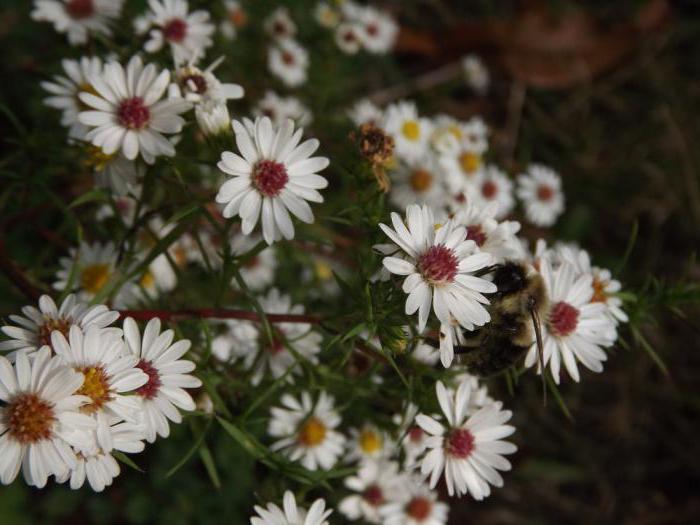

These flowers do not require complex maintenance. Astra ground cover heather is picky, but still, in order for the plant to be healthy and beautiful, efforts should be made. Regular watering is important for her, but it needs to be carried out exclusively with settled warm water. Periodically, you need to apply mineral and organic fertilizers to the soil, they stimulate the growth of the plant. Weeding and loosening should be done as needed. Although aster heather is not very susceptible to diseases and various pests, prevention will not harm it.
It is important to remember that poor soil moisture and a lack of fertilizers lead to the fact that the leaves of the flower quickly turn yellow and wither. This reduces the frost-resistant and decorative properties of the plant.
Possible growing problems
Subject to agricultural technology, plants rarely get sick.
Leaf problems
Fundariosis (wilting begins with the foliage reaches the drying out of the stem) manifests itself on acidic soil, it is treated by liming the soil.
Pests
Aphids are destroyed with insecticides, spider mites - with acaricides for greenhouse plants. Metaldehyde and ground red pepper are effective against slugs.
Diseases
Aster is prone to root rot, the soil is sprinkled with ash, Fitosporin. Brown rot, rust and leaf spot are less common, they are treated with Hom, Topaz fungicides.
Where to plant an aster?
Aster heather is an unpretentious flower, but it looks spectacular in landscape gardening design. Its flowering from September to November adorns garden beds, lining whole carpets of small inflorescences. The plant retains its decorative functions for a long time, which is why asters are very much appreciated by gardeners. The flower has high frost resistance, abundant flowering and does not require special care. Florists know a lot of tricks for growing this plant. First of all, the choice of a place for planting an aster is important.
The plant is very fond of sunlight, so for its cultivation it is better to select open, unshaded areas. The most suitable soil is loamy and sandy loam soil. It is difficult to grow a heather aster if the groundwater in the ground is close to the surface, the plant does not tolerate excess moisture.


Within 4-5 years, a flower transplant is not required to another place; at the end of this period, you need to change the site. This is a kind of prophylaxis to prevent possible diseases.
It is best to choose a site where marigolds or calendula grew before asters. It is undesirable to transplant a flower to places where a carnation, gladiolus or tulip was grown, since these plants are susceptible to furasiosis, which is caused by fungi.
Wintering alpine asters
In the fall, the gardener must necessarily mulch the plants. For this, ordinary soil is taken with the addition of sawdust, sand or dry foliage. This will keep the air cushion near the rhizome, which will prevent the buds from freezing out even in severe frosts and light snow cover. For alpine asters, it is considered normal to hibernate with green aerial parts. If the temperature in your area drops below 28 degrees, you should additionally cover the plants with an armful of foliage, bark or Christmas tree needles.
In the spring, it is advisable to remove melted snow at the planting site in order to prevent moisture stagnation. It leads to decay of rhizomes, buds and young shoots.
Preparing the soil for planting asters
Preparing the soil for planting asters should be done in the fall. Before digging up the earth, humus or compost is introduced into it. Digging should be deep. If the soil is characterized by low fertility, at the beginning of spring it is necessary to fertilize it with mineral components, which are combined with deep harrowing. For these purposes, the following are suitable:
- potassium salt;
- superphosphates;
- ammonium sulfate.
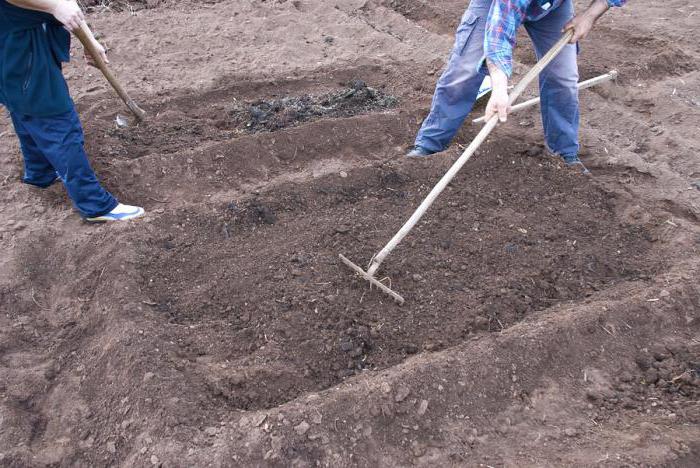

Lime and wood ash are added to the soil with high acidity and to weakly loose soils. If groundwater is nearby, a drainage layer should be provided for growing asters; fine gravel is suitable for this. To improve the structure of the soil, it is recommended to add a little river sand to it.
Before planting itself, you need to remove weeds, loosen and level the soil surface.
Take note when growing asters
- A fairly large number of aster varieties are capable of setting seeds in our central region of Russia. If you like a particular aster variety, you can save your own seeds for next year. To do this, you need to wait until the inflorescences and petals fade, the center will become darker and a white fluff will appear there. These dry inflorescences must be plucked and placed in a paper bag, where the inflorescences will dry further in a warm and dry place.
- You can already start planting aster seedlings in the ground in mid-May, since the aster plant is cold-resistant and can tolerate a drop in temperature to –3–4 ° С.
- Experienced flower growers recommend a mixture of soil, well-rotted manure, peat and river sand in a ratio of 3: 2: 2: 1 for growing seedlings. It is better to prepare the soil mixture in the fall, and steam it in the spring, add a glass of wood ash and a spoonful of nitroammophoska to a bucket of the mixture.
- Black leg
- Universal
- (Youth, Isadora, Assol, Naina) - in 115-120 days,
- Of this disease, before flowering, treat the bush with Topaz 2 times, and after flowering - with a solution of copper sulfate, diluting 50 g of the drug in 10 liters of water.
WateringSoil
Everything is written on the seed bag
Seedling method of growing asters
I sow one part on seedlings at home in March. I sprinkle the soil with clean calcined sand, spread the seeds and sprinkle it a little with sand, cover with a film and germinate in the light, when the seedlings appear, I gradually remove the film and try not to flood the seedlings. I sow the other part of the seeds in April in a small greenhouse, also on the sand. I plant it in open ground as the seedlings grow.
Aster seedling pick
In order not to get confused next year, on a paper bag you need to sign the name of the variety or, in extreme cases, the shape and color of the inflorescences, as well as the year of collection of these seeds. It is worth noting that after a year or two, seeds lose their germination by 40-50 percent.
The site for the aster must be well-lit, even, so that in rainy weather or just watering, the water next to the plants does not stagnate. It is not recommended to plant asters on a site where crops suffering from fusarium have grown over the past years (3-4 years), for example, these are tomatoes, potatoes, etc.
Transplanting aster seedlings into the ground
Immediately remove diseased plants and burn them along with the roots. In their place, plant 2-3 seeds of phytoncidal plants - onions, calendula, nasturtium, marigolds.
... It is recognized by the darkened and thinned stem below, at the root collar. It affects only seedlings, but is not harmful to adult plants. Plants affected by fusarium and blackleg quickly die, since there are no radical methods of their treatment. But there are reliable ways of prevention.
(Queen of the market, Pompom) can fit for both, because with the compactness of the plant, they have strong peduncles and large inflorescences.
Late
The most common problem of perennial asters is their yellowing during bud formation, associated with the fungal disease Fusarium. In the fight against it, spraying plants with a solution of the preparation "Baikal EM-1" helps.
Seedless way to grow asters
... Asters have the greatest need for water during periods of drought and increased growth of the green mass of bushes; at other times, the bushes should be watered as the mail dries up.
... They grow well on loamy soil, neutral in acidity, rich in humus, since they need nutrients and minerals.
I never fiddled with aster seedlings at home. I sow directly into the ground at the end of April, beginning of May. I sow thickly, I do not cover with any film. Each grade is one line or two, I note where which one.
Collecting aster seeds
Asters are generally not very whimsical plants, as long as they have enough moisture during germination. Can be grown in any soil other than too acidic. If you want to grow single bushes, then you can seedlings in March, April. If there is a lot, then sow in rows directly into the ground, which has been well moistened beforehand. If it is cold in April - cover the crops with straw and nothing will happen to them, it will become warm - open
Perennial asters, in other words, just like annual, very light-loving plants, growing in shaded places is certainly possible, but not recommended, in this case the decorativeness of the aster is lost. The soil for a perennial aster should ideally be loamy, not very heavy in its mechanical composition, it should be rich in humus, nutrients, mineral elements, but the acid reaction is best neutral. The soil should also have good moisture permeability. You can not plant asters where there is stagnant water. Generally speaking, perennial asters are not demanding on the soil.
Growing perennial asters
It is necessary to add compost or humus to the soil for seedlings, but it is not recommended to introduce fresh manure, since it can contribute to the defeat of fusarium, it is better to use complex fertilizers or phosphorus-potassium fertilizers. For 1 square meter of area, you need to take 40-60 g of nitrophosphate or 60-80 g of superphosphate and 30-40 g of potash fertilizers, as well as wood ash 100-150 g. It is quite possible to do without fertilization if the soil is already cultivated and has a sufficient amount of nutrients.
By far the main reasons for the popularity
The main thing is proper care of plants. Avoid thickening of crops, excessive humidity and high temperatures in low light and ventilation, excess nitrogen fertilizers.You should not bring fresh manure or humus under the asters, only well-rotted ones. Since fungi, pathogens, persist and accumulate in the soil, in greenhouses and nurseries, it must be changed or disinfected annually by watering with a 0.3% solution of potassium permanganate. In the open field, for the same reason, it is dangerous to return the planting of asters to their original place earlier than in 2-3 years.
Caring for perennial asters
Asters love sunny, non-waterlogged areas of fertile light neutral soil, loamy or sandy loam. To bloom earlier and last longer, grow them through seedlings. The first shoots will appear 5-18 days after sowing the seeds, if sufficient humidity and temperature are maintained at 18-20 degrees. After the formation of the first pair of true leaves, the seedlings dive in a 3 × 4 cm pattern.
(Princess, Radio, Duchess, Blue Frost, Galina) - in 120-130 days.
How to plant an aster correctly?
To get early flowering, it is recommended to plant aster seedlings. Seedlings are planted in open soil in early May. Before this, the soil must be thoroughly shed with water. The distance between the seedlings should be at least 25 cm. The row spacing is done within 50 cm. Since the aster is planted in moist soil, the plant should not be watered immediately after planting. The first watering is carried out 2-3 days after the soil dries.
Within 7 days, the plant will take root, and then you can make top dressing by adding a weak mullein solution under the bush. Before carrying out such a procedure, you should water the flower bush abundantly.


Plants are planted in the evening or in cloudy weather. If the planting took place on sunny days, it is important for young seedlings to provide a little shade.
Requirements for soil, planting site
Shrub asters are native to the prairies of North America and do not pose a problem when rooting even in poor soil. However, most species, especially the popular New England varieties reaching 120-150 cm in height and the New Belgian varieties blooming from mid-August, are recommended to be planted in moderately moist soil, but never permanently moist soil.
A prerequisite for growing is an uncompromisingly sunny position. In the shade, these beautiful flowers suffer greatly, which manifests itself:
- lack of flowering;
- the development of fungal infections.
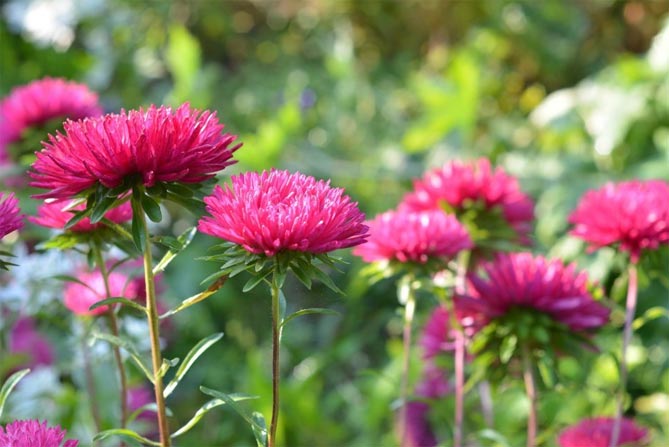

Plant care
Aster heather does not require special care, but nevertheless, in order for the plant to grow strong and healthy and large inflorescences to form on it, it is worth paying some attention to it.
In the hot season, flowers require abundant, but not frequent watering, after which you need to loosen the soil. Asters have a superficial root system, so loosen it carefully, no deeper than 5-6 cm. Excessive moisture is contraindicated for the plant, but drying out of the soil leads to rapid wilting. Everything should be in moderation.
To reduce the risk of furaziosis, it is recommended to regularly weed the weeds near the flower. With proper care, the plant develops without diseases and pests.
To prolong flowering, you need to periodically remove inflorescences that have withered, leaving only a few pieces so that the seeds ripen.
Perennial varieties are resistant to low temperatures, so they do not require shelter in winter.
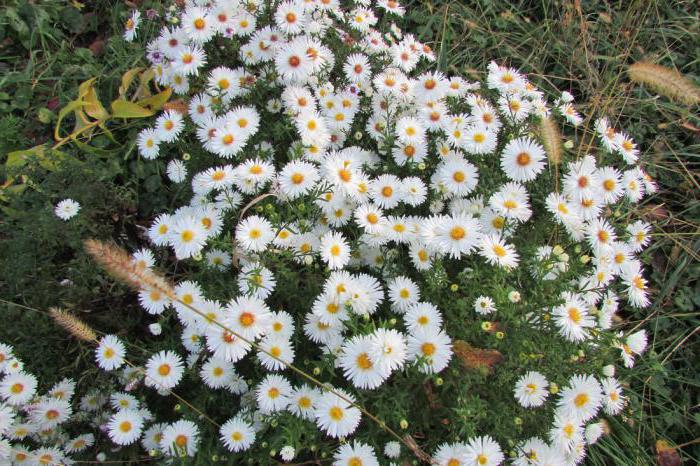

Diseases and pests
Asters are perennial plants that usually hibernate in soil without problems. After cutting the shoots in the fall, you need to cover the root zone with an additional layer of compost soil or bark. Older plants are more likely to get sick, bloom less, so they need to be rejuvenated every 3 years by replanting by dividing the bush, as described above.
Powdery mildew
A much more serious problem is powdery mildew. This is a fungal infection that often attacks asters.The disease is manifested by the appearance of a white coating on the leaves, resembling flour slightly soaked in water.
Varieties of the New Belgian species are especially sensitive to powdery mildew. Powdery mildew should be dealt with using aerosol fungicides such as Topaz.
Fungal diseases
Fungal diseases affecting asters can be prevented by avoiding over-watering and taking care not to wet the leaves during irrigation. The aforementioned root ball splitting every few years is also good preventive maintenance.
Jaundice of asters
The disease manifests itself at the initial stage by yellowing of the leaf along the veins. Then the whole plant turns yellow-green. The shoots are weakening, the leaves are thinning. The flowers turn yellow-green, distorted.
The disease is caused by phytoplasmas. Reasons for the appearance:
- phytomlasma is transmitted mainly by insects;
- possible infection during reproduction along with vegetative material.
Phytoplasm cannot develop outside the host. If the plant dies, the phytoplasmas also die. Unfortunately, there are no effective ways to combat them if the infection has already taken root. Misdiagnosis causes unnecessary and unjustified use of fungicides or bactericides in home gardens. Diseased plants need to be dug up and burned.
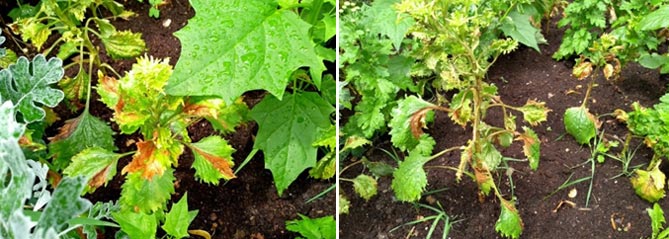

Leaf curl
Wrinkled, curled leaves are a symptom of this infection. Viral disease leads to inhibition of the growth of asters. No drugs will help. You need to dig up the plants and burn them.
Fusarium (rotting)
The disease attacks from the soil; it is in the soil that the source of the infection is contained. Asters turn brown, wither. One solution is to transplant the plant to a different, healthy location, because the contaminated soil can infect the seedlings for several years. Fungicidal spraying is carried out not only on the plant, but also on the soil.
Aphid
Sometimes the aster is affected by aphids. To combat the pest, a soap solution is used, which must be sprayed 2-3 times a day until the insects recede.
Seed propagation
Planting plant seeds in open ground gives a good result. It can be done in spring, late autumn and even at the beginning of winter:
- Spring planting is carried out in the first half of May. The seeds are placed in the ground to a depth of no more than 2 cm and watered with warm water. The soil is mulched using peat and compost. Fresh seeds have good germination, in a week the sprouts will break out of the ground. A little later, the plants should be thinned out, leaving a distance of less than 15 cm between them.
- In late autumn (mid-November), seeds are planted in frozen ground. Furrows are prepared in advance before the onset of cold weather. Pits with seeds are sprinkled with dry warm compost.
- In winter, sowing is carried out from December to January, but this is only if the snow cover is at least 10 cm thick. You need to prepare the furrows in the fall. The seeds are planted directly in the snow. From above, the beds are covered with dry mixtures of humus or compost. As soon as the thaw comes, the seeds will be in a favorable environment and will sprout quickly.
Aster groups by height
- CareLocation
- If you want flowering in June-July, then sow in early February, if in August-September, then in March-April. Asters need to grow 3-4 months before flowering. I germinate seeds in a napkin, naklyuyutsya-sow, deepening by 0.5 cm.I just plant it on seedlings in April like everyone else, and later in May in the ground
- Cultivation of asters is also possible with winter sowing, i.e. seeds are sown in frozen, prepared soil, shoots appear in spring, plants are thinned out. It should be noted that asters grown in winter sowing are much less susceptible to fusarium.In cases where, when picking, you notice a strongly elongated hypocotyl knee in the plants, these seedlings can be deepened into the soil into the flesh to the cotyledon leaves. 1 week after the picking, it is necessary to feed the seedlings a little, such feeding should be carried out once a week.
Reproduction by division
You can plant perennial asters by dividing the bush. In this case, the plant must be at least 5 years old. They are planted in the autumn, immediately after the end of flowering. The division should be done very carefully, as the root system of the aster is very delicate. After planting, the plant does not have time to fully grow stronger before frost, therefore it is recommended to cover it with dry foliage or spruce branches.
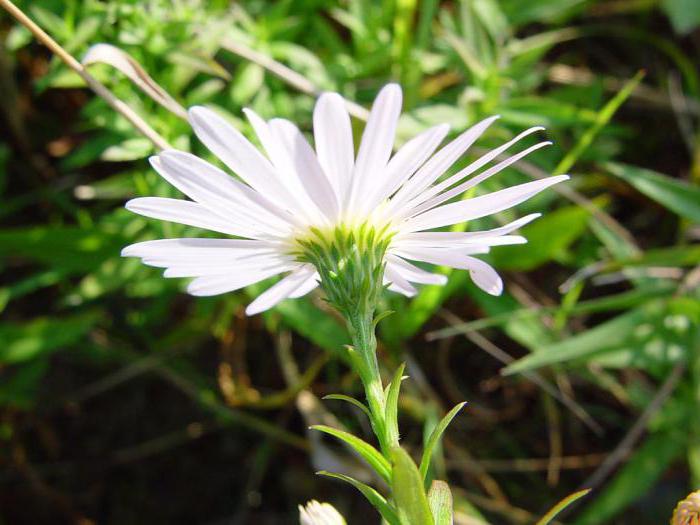

A bit of history and legends
On the flower beds of our latitudes, perennial and annual asters have been growing for a long time and are already common everywhere.
These unpretentious flowers that adorn autumn flower beds and gardens are among the most ancient flowers and have a more ancient history than it seems at first glance. Their modest beauty was appreciated by early civilizations, although they did not cultivate them. For example, in Ancient Greece, the perennial aster was dedicated to the goddess Aphrodite, and in China, burning the leaves of plants in the fall, they believed that they chased away snakes. And bouquets of asters were given to beloved ones.
Flowers have been cultivated in European countries since the end of the 17th century. During this time, flower growers have grown many varieties of these flowers of indescribable beauty and a variety of shades. Terry varieties were first bred in France, and in the 19th century several of the most beautiful varieties were bred in the United States. In the 20th century, around the 30s, Soviet breeders were engaged in the cultivation of these flowers, they were also able to breed several varieties. The flower is liked by breeders because it almost does not need care.
Popular types of perennial asters in Russia
Recently, gardeners have preferred planting perennial asters. Their bloom of purple, blue and lilac shades begins in late August - early September and lasts until late autumn. Plants are unpretentious and do not need careful maintenance. Heather aster is very popular in the USA and European countries, while in Russia the most famous varieties of perennial asters are:
- New Belgian.
- Shrub.
- New English.
- Alpine.
If you want to create a piece of paradise in your garden that will delight you with its flowering until late autumn, you should turn your attention to such a flower as aster heather ground cover. Planting and caring for a plant does not cause any particular difficulties, and even an amateur gardener can cope with them.
Popular varieties of white, blue, pink species
Aster novi-belgii (Aster novi-belgii)
The required shade can be found among both early and late varieties. The choice is wide enough, and on average each variety blooms for 35-40 days.
Albus is a white semi-double aster with a yellow curly core, blooming from June to July. Height - from 15 to 20 cm. Flowers up to 4 cm in diameter. Prefers partial shade and moderate watering.
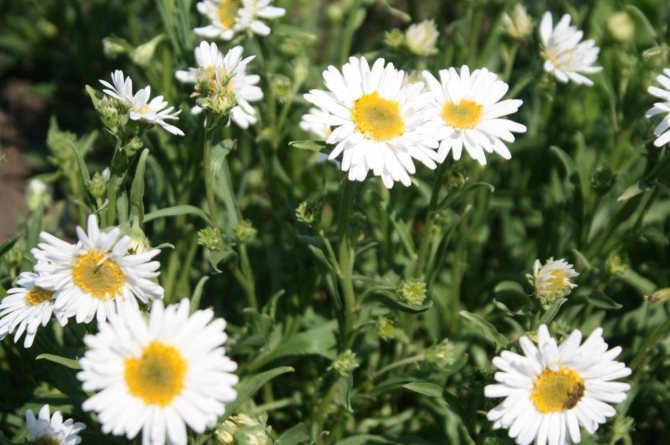

Albus
Happy End is a fairly tall variety and very popular, up to 30 cm high, blooming with bright pink or violet-blue flowers with a yellow center (up to 4 cm in diameter) from May to June. Greens do not lose their appearance even after the onset of frost.
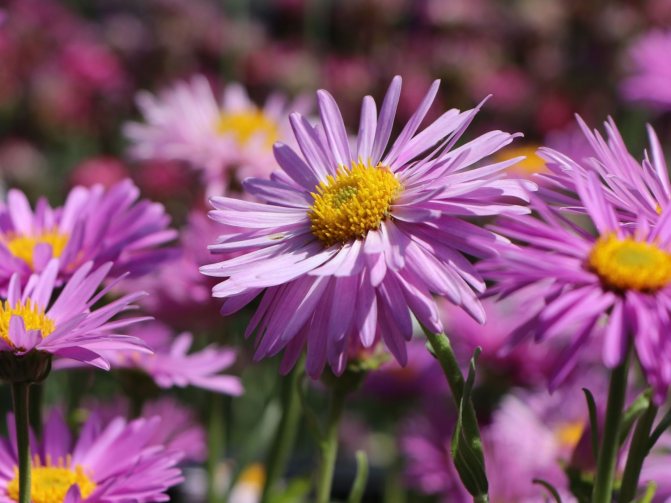

Happy end
Goliath - the variety got its name for its very large (up to 6 cm in diameter) flowers, the shade of which can vary from pale pink to sophisticated lilac-blue (cornflower blue). Bushes up to 20 cm high. Flowering lasts all June.


Goliath
Ruber - the variety has a standard foliage for this type, flowers (up to 4 cm in diameter) have a bright crimson color. Early flowering - covers May and June. Bushes grow up to 30 cm high, and grow up to 50 cm wide.
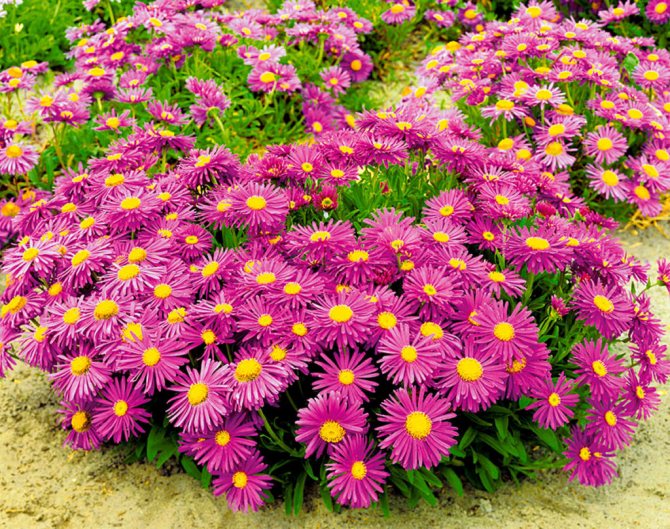

Ruber
Violetta is a new hybrid variety, belongs to the blue variety of Alpine asters (blue). It blooms from May to June with lush cornflower blue flowers (up to 5 cm in diameter). The height of the bushes is up to 40 cm. Suitable for cutting.
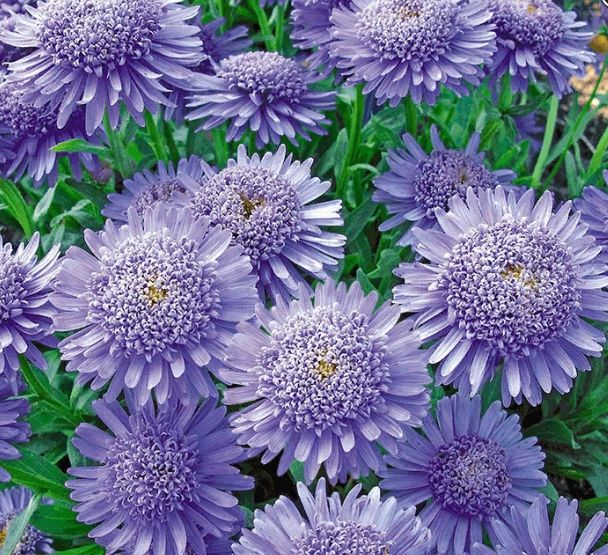

Violet
Dunkle Schone is perfect for fans of purple paints. On bushes up to 30 cm high, many flowers (up to 5 cm in diameter) bloom in a rich purple hue.The foliage during seed germination is at first grayish, and then becomes dull green.
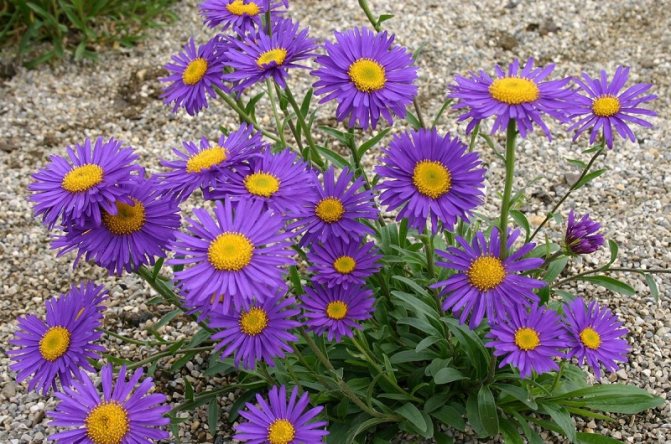

Dunkle schone
Application in landscape design
Aster heather is valued as a ground cover crop. It is used in rock gardens, park areas in combination with conifers. Low-growing varieties are planted next to Iberis, cloves. Tall varieties go well with rudbeckia and ornamental yarrow.
Single plantings of heather aster look dignified and beautiful. Designers give lush bushes the correct geometric shape (ball, cone). A decorative perennial planted in the garden decorates it for many years without requiring much maintenance.
Healing properties
Alpine aster is famous not only for its magnificent appearance, but also has a certain list of medicinal properties. In Tibet, for example, herbal teas have been used since ancient times to treat eczema, scrofula, cough and bone pain.
This flower is rich in various flavonoids, coumarins and saponins, thanks to which it exhibits significant antipyretic and expectorant effects. Aster infusions, applied externally, help to reduce itching in various dermatitis and other skin lesions.
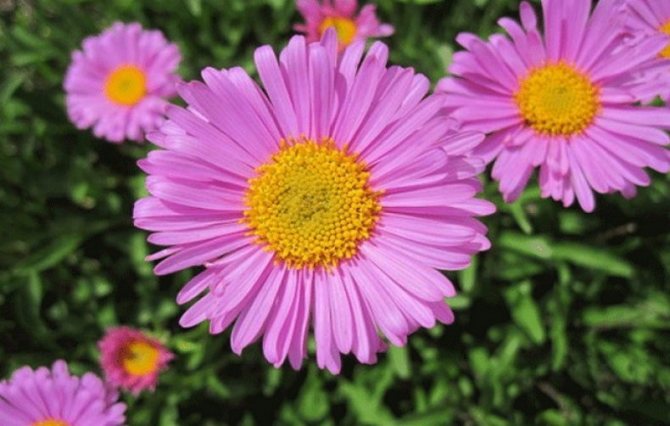

Decoctions from it can also be taken orally for the purpose of treating and preventing various diseases of the gastrointestinal tract, colds, joint diseases, tuberculosis and flu.
Traditional healers recommend various infusions made from aster for the treatment of malaria and as hemostatic drugs. For older people, these infusions have a tonic and invigorating effect.
It is believed that drugs based on it help in the treatment of neurasthenia and dizziness, it is possible to use them as anthelmintic drugs.
Disease protection
Perennial alpine aster has good resistance to many diseases, however, unfavorable growing conditions can cause damage to plants with powdery mildew or fusarium. When the first signs of pathology appear, the affected plant parts must be removed and destroyed, and the perennial aster bushes must be treated with antifungal drugs or Bordeaux liquid.
Insect pests can also appear on plants - spider mites, caterpillars or slugs, for protection from which various means are also used. Processing of aster flowers with ash or soap solutions is effective. But the best prevention of disease is to provide comfortable conditions for flower development.
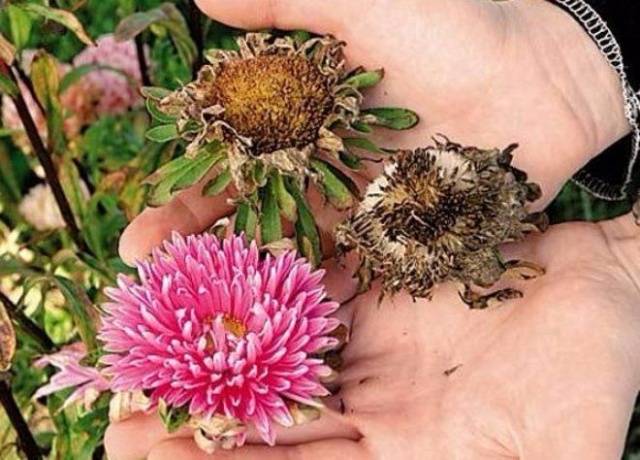

Alpine aster (perennial): growing from seeds - from seed to flowering!
Good day everyone!
The last article was about the one-year-old aster - the beauty of the autumn garden. I can't stop and continue the story about asters. Today, the heroine of the article is Alpine Astra perennial: growing from seeds. It blooms unusually early for an aster - in May-June, about a month. Small flowers, about 5 cm in diameter, resemble simple multi-colored daisies. Usually, the bushes of alpine asters are low - 25-30 cm, the color of the flowers is very different: lilac, pink, blue, white, crimson.
They grow well in lush bushes and look great on slides, rockeries, in the form of a border, and in a single planting or in small groups. For lush flowering, you need to pinch the shoots and remove the fading flowers.
Seed purchase - what should be the seeds?
For flower cultivation, it is very important to choose the right planting material. First of all, when buying, you need to pay attention to the year of release and the expiration date of the seeds. We advise you to buy only the freshest seeds, since asters tend to quickly lose their germination. Experts advise against buying seed packed in bright, eye-catching sachets. In practice, it has been proven that higher quality seeds are produced in ordinary transparent bags, giving a better flower yield.
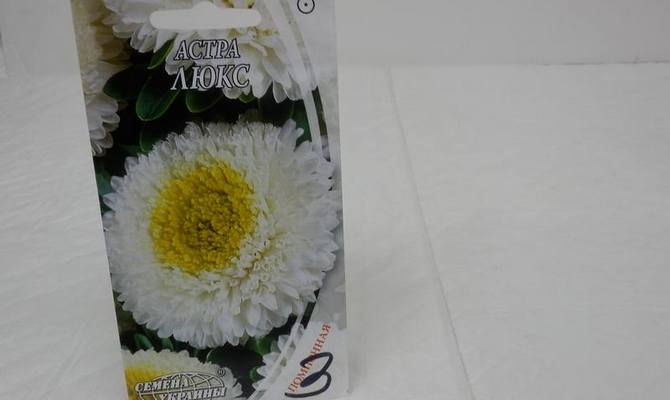

In order to create original flower beds with your own hands, we recommend choosing various mixtures of asters. In bags with such material there are up to 12 different colors. If you want to make a flower bed with a specific pattern - squares or stripes, then buy bags, each of which contains flower seeds of one specific shade.
Landing
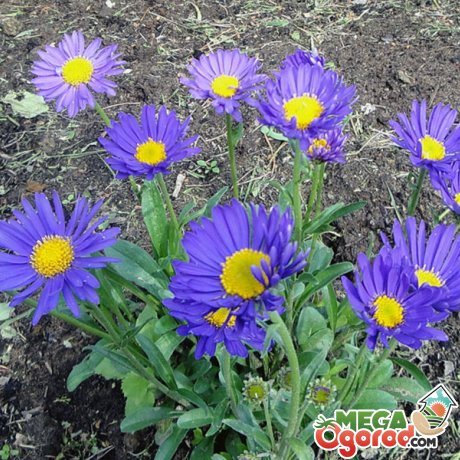

Alpine aster loves the sun's rays. Therefore, it must be planted in a spacious area. It tolerates light shading well. Alpine aster should not be planted in the shade. There, the stems of the plant stretch out, and the flowers stop forming.
Alpine aster does not have any special requirements. But it grows best in nutrient-rich alkaline soils. If it is not acidic enough, add slaked lime, dolomite flour. Then the flowering will be abundant and long-lasting, and the flowers will be large and bright.
It is desirable that the air passes well to the roots of the plant, and moisture does not stagnate in the roots of the plant.
Young shoots appear on the stem of the plant in spring or summer. Flower buds are formed on them, they are used for propagation by cuttings. The root system of the alpine aster is superficial. Therefore, groundwater usually does not flood it. But rains or spring floods can harm the plant. If the threat of flooding is real, then before planting, you need to build a drainage, pouring sand, fine gravel or expanded clay below the root system. Then a layer of soil is poured and the plants are planted.
When planting seedlings, they deepen them a couple of centimeters lower than they were in the pots. The distance between the plants in a row is 20 cm, between the rows is 40 cm. A groove for irrigation is formed between the rows. Plants are mulched.
Proper care - what is the success of experienced florists?
There are several secrets on which active growth and long periods of asters flowering depend. To be successful in growing these flowers, you must;
- avoid temperature drops;
- feed plants;
- regularly harden the grown seedlings;
- water the plants correctly;
- avoid drafts in the early stages of growing.
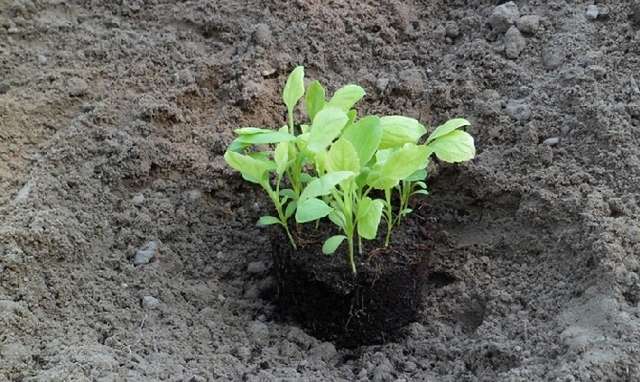

It is necessary to moisturize the seedlings of asters infrequently, but abundantly. Be sure to drain the bottom of the pots to avoid stagnant water. You do not need to fill the flowers with water, otherwise your seedlings will become infected with a black leg. It is very important to protect the plants from sudden temperature fluctuations and drafts. This is especially true for young immature seedlings. To do this, for several months before the first pick, the plants should be in one rarely ventilated room.
Description of the species and its origin
Asters flowers are unique, because they can grow even in the most unfavorable regions, bloom the longest, and there is a very wide variety of them. Moreover, each flower and variety is like a separate unique natural masterpiece. Asters are striking in a variety of shades, among which there are burgundy, purple, lavender and rare blue. Seeds can be bought all over the place.
Alpine aster is one of the main species, from the name you can understand where this variety comes from. Yes, in the wild, such flowers prefer to grow in mountainous regions, on the slopes of hills. Moreover, if you have not yet understood, then this is a species, and it already includes many different varieties for every taste. What are these flowers remarkable for? For example, the timing of flowering.
Asters can bloom early, summer and autumn, along with chrysanthemums. It is not so often that you can see flowers in the garden that are already pleasing in May, and these are not primroses. It is the alpine aster that can bloom in the spring. To do this, it is planted by the seedling method. But you can sow seeds directly into the soil, which gives another great advantage to asters. Yes, they are rarely afraid of return frosts and grow rather quickly, the main thing is to choose a good place and soil. But more on that later.
Alpine aster is a perennial, it can grow for more than one year in one place, but in order for the bush to be beautiful, it is better to update it and replant it every 3-4 years. This flower belongs to the numerous Asteraceae family. The root system is well developed, it is parallel to the ground. It begins its growth with a rosette of leaves, which, as the stem grows, become smaller towards its end, a bud begins to form here. Flowers are located in baskets, where there can be up to 25-30 pieces.
On a note! Many people confuse asters with simple daisies, chrysanthemums and daisies. Still, these are different flowers with their own requirements for soil and care. The main colors are white, pink, lilac, crimson, blue.
The height of the bushes is up to 35 cm, there are also smaller representatives of the species - up to 15-20 cm, which makes them an ideal decoration for borders, alpine slides, paths. Flowers look great in flower bed arrangements and simply planted in rows. You can even create a drawing using different colors of alpine stunted asters.
The advantages of the seedling method
The garden plant has a variety of shapes and colors. Aster is represented by more than 4000 varieties. Difference: flowering time, height, structure and other characteristic differences.
Early, late, medium varieties can get along well in one place. Despite the fact that aster is considered a perennial crop, there are also annual varieties. Popular became:
- Chinese or callistephuses;
- New English;
- new belgian.
Each variety looks special, as it reaches a height of 25 cm and up to one and a half meters. Baskets differ in shape. So you can see wreath or curly, semi-double or spherical, as well as needle-like.
There are also many shades, because breeders are trying to diversify the palette. Therefore, they are already acquiring not only white or purple, but green and orange flowers.
Seedling option for sprouting asters helps to get resistant flowers to diseases. After all, for a certain time, boring is supervised.
After the pick, there is time to strengthen the root system, feed or carry out prevention.
If you carry out a seedless planting, then problems are added:
- The young aster does not have time to get stronger. Therefore, it is susceptible to infection with fungal and other diseases.
- Pests are looking for juicy shoots in the spring, which means that aster sprouts can become food.
- The temperature regime is not always stable after planting the seeds. Frost damages the growth and development of the flower.
If the seedlings are pre-hardened, after germination at home, the grower will not be able to worry about the wintering of perennial asters.


Planting asters in a seedling and seedless way
You can harvest aster seeds yourself, collecting them from dried inflorescences at the end of summer, or purchase seeds in the store for each season, experimenting with different varieties of asters. The main thing is that the seeds are of high quality, then the seedlings will sprout up to 100%.
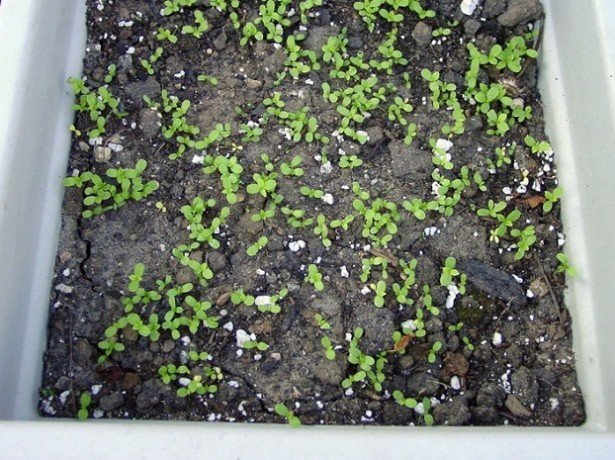

Planting asters in a seedling way
Seedless way
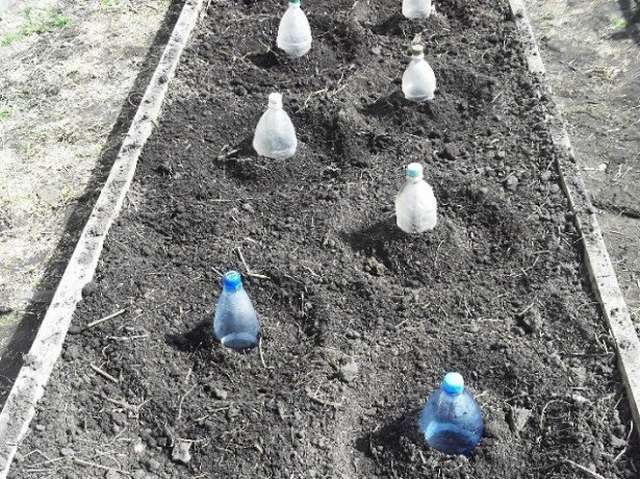

Seedless sowing of asters
Aster seeds are sown as soon as the ground warms up, directly on the flower beds, sprinkling a little earth on top and covering with a film until germination. With the appearance of young seedlings, the film can be removed and covered only in case of frost. It is not necessary to dive them, it is enough to sow them at intervals of a couple of centimeters, and then thin them out so that between the plants it turns out to be 12 cm, or leave the plantings thickened. Asters, planted in a seedless way, begin to bloom much earlier.
Problems and solutions
Aster flower is not a problem. It usually does not have any difficulties with her, even for novice florists. But if something went wrong, it will be enough just to adjust the care and everything will work out. What can happen to aster?
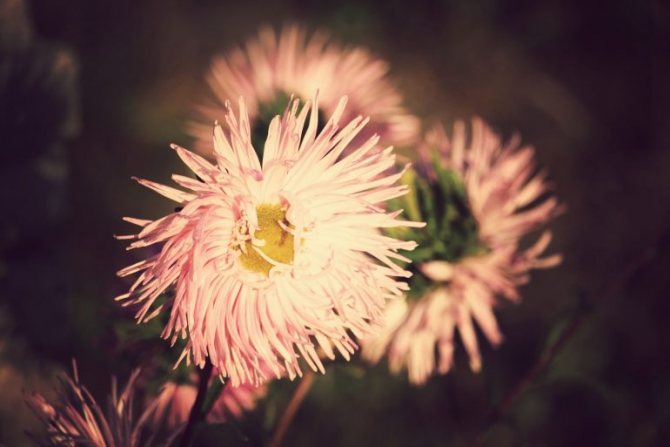

Photo: https://enn.imadeself.com/photos/astra-autumn-roses-in-the-fall-3733496/
| Problem | Cause |
| The undersized variety stretched out strongly upward and did not bloom. | Lack of lighting. Perennial asters prefer well-lit sunny areas. |
| When growing seedlings from seeds, black stripes appeared on the stems. | Due to excessive moisture, the seedlings begin to rot. This disease is called black leg. The seedling must be removed, and the rest of the healthy seedlings must be treated with a solution of potassium permanganate for prevention. Afterwards, try not to overmoisten the soil. |
| The middle of the bush dries up, and the side shoots become weak. Flowering is not as abundant as usual, and the inflorescences themselves are small. | The bush is old and requires rejuvenation. It is necessary to divide the bush into several parts and transplant each division separately. |
| Aster blooms with defective inflorescences. | Check for aphids or spider mites. If they are not there, then the reason is lack of nutrition or improper care. |
Don't plant asters after tulips, gladioli, tomatoes, potatoes and yourself!



